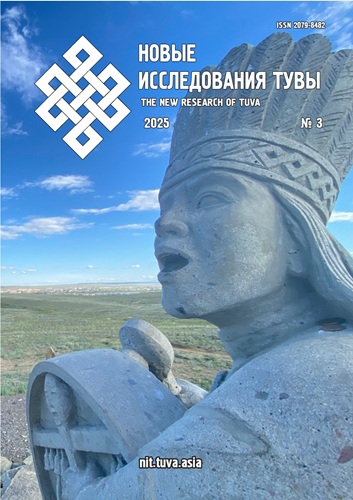Тюркский культурный мир России: локусы, проблемы и перспективы изучения
DOI:
https://doi.org/10.25178/nit.2025.3.22Ключевые слова:
тюркский язык; тюркская культура; культурный мир; тюрки; тюрки России; российскаянаука; ассиметрия; ядро культуры; концепт культурыАннотация
В статье анализируются особенности и проблемы изучения тюркского культурного мира России в современной российской науке.. Тюркский культурный мир — это больше, чем родственные языки, это пространство множества культур, имеющих общность в определенных основаниях: истоков истории, мифологии, фольклора, традиций литературы, и этнического самосознания и ряда культурных традиций. Тюркский культурный мир России является его локальной частью.
Он сам состоит из локусов разных культурных миров, что заметно при применении методов культурной географии. Это лингвистический культурный ландшафт распространения тюркской языковой группы алтайской языковой семьи. Особенностью российских тюрков является тюркско-русский билингвизм. Общей характерной чертой их социокультурной жизни можно назвать историческую — общность истории. В религиозном плане тюркский культурный мир России насчитывает локусы исламского мира, буддийского и шаманистского, христианско-православного. Есть и целый ряд существенных отличий. При этом, современная, мозаичная тюркская культура демонстрирует наличие в культуре «ядра», т. е. глубинного внутреннего слоя, которое имеет относительно устойчивый характер.
Однако, для изучения ее необходимы определенные условия, возможности науки, ученых. Описываются проблемы российской науки в связи с этим: ассиметрия, проблемы планирования и финансирования, проблемы региональных ученых-инсайдеров.
Предлагаются «сквозные» темы для того, чтобы оптимизировать исследовательские стратегии. В том числе предлагается использовать методологию концептуализации этнокультур, чтобы обсуждать концепты культур из «ядра» каждой культуры, общие для тюрков.
Библиографические ссылки
Абжанов, Х. М. (2015) Древние тюрки и современные тюркские народы Центральной Азии: истоки историко-духовной общности // Мир Большого Алтая. № 1. С. 12–20.
Аватков, В. (2014) Неоосманизм. Базовая идеологема и геостратегия Турции // Свободная мысль. No 3. С. 71–78.
Аватков, В. А. (2019) Идейно-ценностный фактор в тюркских государствах постсоветского пространства //Мировая политика. № 4. С. 1–12. DOI: https://doi.org/10.25136/2409-8671.2019.4.31235
Азербайджанцы (2017) / отв. ред. А. Мамедли, Л. Т. Соловьева. М. : Наука. 708 с.
Акрамов, Н. М. (1963) Выдающийся русский востоковед В. В. Бартольд. Научно-биографический очерк. Душанбе : б. и. 112 с.
Аязбеков, С. А. (2023) Буддизм и тюркская цивилизация: межкультурный и социально-политический дискурс // Respublica Literaria. Т. 4. № 3. С. 162–173. DOI: https://doi.org/10.47850/RL.2023.4.3.162-173
Бартольд, В. В. (1968) Сочинения : в 9 т. М. : Наука. Т. V. Работы по истории и филологии тюркских и монгольских народов. 757 с.
Бартольд, В. В. (2002) Работы по истории и филологии тюркских и монгольских народов. М. : Восточная литература. 757 с.
Бахтикиреева, У. М., Валентинова, О. И., Рыбаков, М. А. (2019) Факторы типологической комплементарности славянских и тюркских языков в свете системной лингвистики и этнологии // Филологические науки. № 3. С. 21–30. DOI: https://doi.org/10.20339/PhS.3-19.021
Бахтикиреева, У. М., Валентинова, О. И. (2022) Особенности «языкового мышления» с позиций системной лингвистики // Russian Journal of Linguistics. Т. 26. № 1. С. 224–244. DOI: https://doi.org/10.22363/2687-0088-30149
Башкиры (2015) / отв. ред. Р. Г. Кузеев, Е. С. Данилко. М. : Наука. 662 с.
Благова, Г. Ф. (2012) История тюркологии в России (вторая половина XIX — начало XX в.) : в 2-х ч. М. : Восточная литература РАН. 310 с.
Боргоякова, Т. Г., Гусейнова, А. В. (2017) Статус и функционирование тюркских языков Южной Сибири. Абакан : Хакасский гос. унив. им. Н. Ф. Катанова. 136 с.
Бухарова, Г. Х. (2010) Башкирский народный эпос «Урал-Батыр»: когнтивно-дискурсивый и концептуальный анализ. Уфа : Вагант. 352 с.
Вежбицкая, А. (2011) Семантические универсалии и базисные концепты. М. : Языки славянских культур. 568 с.
Губогло, М. Н. (2005) Этноязыковая и этнодемографическая панорама тюркского мира России // Русский язык в тюрко-славянский этнокультурных взаимодействиях / сост. А. Д. Коростелев, отв. ред. М. Н. Губогло. М. : Старый сад. 447 с. С. 12–53.
Джусупов, М. (2014) Русский и тюркские языки // Studia Rossica Posnaniensia. № 39. С. 40–48. DOI: https://doi.org/10.14746/strp.2014.39.3
Евразийство: ключевые идеи, ценности, политические приоритеты (2007) / А. В. Иванов, Ю. В. Попков, Е. А. Тюгашев, М. Ю. Шишин. Барнаул : Азбука. 243 с.
Закиев, М. З. (2011) Глубокие этнические корни тюркских народов. Астана : Кантана Пресс. 400 с.
Кабжанов, А. Т. (2019) Тенгрианство — основа национальной самоидентификации казахов // Тенгрианство и эпическое наследие народов Евразии: истоки и современность : сборник статей VII Международной научно-практической конференции, Бишкек, Кыргызстан, 21–22 июня 2019 года / отв. ред. Л. Федорова. Бишкек, Кыргызстан: Международный фонд исследования Тенгри (МФИТ). 360 с. С. 138–141.
Кабо, Р. (1947) Природа и человек в их взаимных отношениях как предмет социально-культурной географии // Вопросы географии. Вып. 5. С. 5–32.
Карачаевцы. Балкарцы (2014) / отв. ред. М. Д. Каракетов, Х.-М. А. Сабанчиев. М. : Наука. 815 с.
Керимли, В. Г., Гайбурова Н. В. (2020) Культура тюркских народов Кавказа: концептуальный подход // Евразийский союз ученых. № 6. С. 32–36.
Кляшторный, С. Г. (1981) Мифологические сюжеты в древнетюркских памятниках // Тюркологический сборник. 1977 / отв. ред. А. Н. Кононов. М. : Главная редакция восточной литературы. 298 с. С. 117–138.
Кононов, А. Н. (1974) Некоторые итоги развития советской тюркологии и задачи советского комитета тюркологов // Советская тюркология. № 2. С. 3–12.
Кыргызы (2016) / отв. ред. А. А. Асанканов, О. И. Брусина, А. З. Жапаров. М. : Наука. 623 с.
Ламажаа, Ч. К. (2018) Национальный характер тувинцев. СПб. : Нестор-История. 240 с.
Ламажаа, Ч. К. (2020) Единство и своеобразие современных этнических культур народов Центральной Азии: три исследовательских проблемных поля // Новые исследования Тувы. № 4. С. 201–216. DOI: https://doi.org/10.25178/nit.2020.4.14
Ламажаа, Ч. К. (2021) Тува как лимитрофная зона: язык, религия и идентификация тувинцев // Новые исследования Тувы. № 3. С. 178–194. DOI: https://doi.org/.25178/nit.2021.3.14
Ламажаа, Ч. К. (2023) Концепты культуры: форма, идея, социальная регуляция // Новые исследования Тувы. № 1. С. 6–25. DOI: https://doi.org/10.25178/nit.2023.1.1
Ламажаа, Ч. К., Каиржанова, А. Т. (2025) Башкы: обращение, наставничество и социальные отношения // Новые исследования Тувы. № 1. С. 5–25. DOI: https://doi.org/10.25178/nit.2025.1.1
Мамедов, Н. М. (2017) Основания единства и многообразия Тюркской культуры // Этносоциум и межнациональная культура. № 9 (111). С. 148–155.
Мельников, Г. П. (2003) Системная типология языков: принципы, методы, модели. М. : Наука. 395 с.
Насилов, Д. М. (2009) Российская тюркология наших дней // Российская тюркология. № 1. С. 3–7.
Попков, Ю. В. (2023) Этнокультурный неотрадиционализм: рефлексивно-интеграционная теоретическая модель // Этнография. № 3. С. 203–223. DOI: https://doi.org/10.31250/2618-8600-2023-3(21)-203-223
Попков, Ю. В., Тюгашев, Е. А. (2022) «Затерянный мир»: тувинская культура в центр-периферийной интерпретации геокультурного и социокультурного пространства // Новые исследования Тувы. № 1. С. 225–236. DOI: https://doi.org/10.25178/nit.2022.1.15
Потапов, Л. П. (1978) Древнетюрские черты почитания Неба у саяно-алтайских народов // Этнография народов Алтая и Западной Сибири / отв. ред. А. П. Окладников. Новосибирск : Наука. 226 с. С. 50–64.
Проблема междисциплинарности в контексте реформ российской науки. Материалы «круглого стола» (2016) // Философия науки и техники. Т. 21. № 1. С. 5–35.
Райхл, К. (2008) Тюркский эпос : традиции, формы, поэтическая структура. М. : Восточная литература. 383 с.
Российская нация : Становление и этнокультурное многообразие (2011) / под ред. В. А. Тишкова. М. : Наука. 462 с.
Севастьянов, И. В. (2023) Кряшены: православные в тюркском мире. М. : ИЭА РАН. 304 с.
Стеблева, И. В. (1972) К реконструкции древнетюркской религиознол-мифологической системы // Тюркологический сборник. 1971 / отв. ред. А. Н. Кононов. М. : Главная редакция восточной литературы. 296 с. С. 213–226.
Тишков, В. А. (2013) Российский народ: история и смысл национального самосознания. М. : Наука. 649 с.
Ткаченко, А. А. (1996) Тюркские народы: возрождение или развитие // Этнографическое обозрение. № 4. С. 65–75.
Тувинцы: родные люди (2022) / Ч. К. Ламажаа, Н. Д. Сувандии, Ш. Ю. Кужугет, Ш. Б. Майны; под ред. Ч. К. Ламажаа, Н. Д. Сувандии. СПб. : Нестор-История. 344 с.
Тува. Родная земля (2023) / Ламажаа Ч. К., Сувандии Н. Д., Кужугет Ш. Ю., Майны Ш. Б., Санчай Ч. Х.; под ред. Ч. К. Ламажаа, Н. Д. Сувандии. СПб. : Нестор-История. 344 с.
Туровский, Р. Ф. (1998) Культурные ландшафты России. М. : Институт наследия. 210 с.
Тюркские языки в евразийском пространстве: современное состояние, тенденции и перспективы (2012) / Н. Ж. Шаймерденова, Д. М. Насилов и др. Астана : Сарыарка. 367 с.
Тюркские языки и этносы: языковые и этнодемографические процессы (2015) / Э. Д. Сулейменова, Н. Ж. Шаймерденова, Д. М. Насилов и др. Алматы : Қазақ университеті. 381 с.
Фахриева, Л. М., Давлетшина, Л. Х. (2021) К вопросу классификации мифологических персонажей турецкого фольклора // Тюркологические исследования. № 4 (1). С. 7–20.
Федорова, Л. В. (2017) Возрождение тенгризма как религиозного учения в наши дни // Тенгрианство и эпическое наследие народов Евразии: истоки и современность : сборник статей VI-й Международной научно-практической конференции, Астана, Казахстан, 14–16 июня 2017 года / отв. ред. Л. В. Федорова. Астана : ТОО «Мастер По». 509 с. С. 404–411.
Федорова, Л. В. (2023) Тенгризм. Якутск : Издательский дом СВФУ. 596 с.
Червонная, С. М. (1999) Тюркский мир в центре Северного Кавказа: парадоксы этнической мобилизации. М. : ЦИМО. 326 с.
Чуваши (2017) / отв. ред. В. П. Иванов, А. Д. Коростелев, Е. А. Ягафова. М. : Наука. 654 с.
Шаманов, И. М. (1982) Древнетюркское верховное божество Тенгри (Тейри) в Карачае и Балкарии // Проблемы археологии и этнографии Карачаево-Черкесии / отв. ред. Е. П. Алексеева. Черкесск : Карачаево-Черкес. НИИ истории, филологии и экономики. 224 с. С. 155–170.
Этническое и религиозное многообразие России (2017) / под ред. В. А. Тишкова, В. В. Степанова. М. : ИЭА РАН. 551 с.
Jordan, T., Rowntree, L. (1986) The Human Mosaic. A Thematic Introduction to Cultural Geography. New York : Longman. 455 p.
Sauer, K. (1925) Morphology of Landscape // University of California Publications in Geography. Vol. II, no. 2. P. 19–54.
Sauer, K. (1927) Recent Developments in Cultural Geography // Recent Developments in the Social Science. Ed. by E. C. Hayes. New York : Lippincott. 428 p. P. 154–212.
Опубликован
Как цитировать
For citation:
Lamazhaa Ch. K. The Turkic Cultural World of Russia: Loci, Problems, and Research Prospects. New Research of Tuva, 2025, no. 3, pp. 371-388 (In Russ.). DOI: https://doi.org/10.25178/nit.2025.3.22
Выпуск
Раздел

Это произведение доступно по лицензии Creative Commons «Attribution-NonCommercial» («Атрибуция — Некоммерческое использование») 4.0 Всемирная.

Автор (лицензиар) произведения предоставляет простую (неисключительную) лицензию на использование редакцией (лицензиатом) произведения науки, который заключается в упрощённом порядке (открытая лицензия), согласно ст. 1286.1. «Открытая лицензия на использование произведения науки, литературы или искусства» Гражданского кодекса Российской Федерации.
В нашем издании публикуемые материалы доступны по лицензии Creative Commons «Attribution-NonCommercial» («Атрибуция — Некоммерческое использование») — CC BY-NC.
Т. к. лицензия открытая, автор имеет право разместить статью после ее выхода на своем сайте, читатель может скопировать и разместить на своих персональных ресурсах, в том числе в виде выдержек, конспектов, но:
а) обязательно должно быть указано ФИО автора, неизмененное название статьи и гиперссылка на первоисточник (журнал «Новые исследования Тувы»),
б) размещающий не имеет права брать деньги за доступ к этому материалу или каким бы то ни было образом давать преимущество одним читателям над другими,
в) при перепечатке автором текста статьи без значительных изменений (если сохраняется 30% текста или более) должно быть указано, что первая редакция статьи вышла в журнале «Новые исследования Тувы» и сделана соответствующая ссылка.
Лицензия действует по всему миру, длится в течение срока авторских прав на произведение, является неотзывной.









